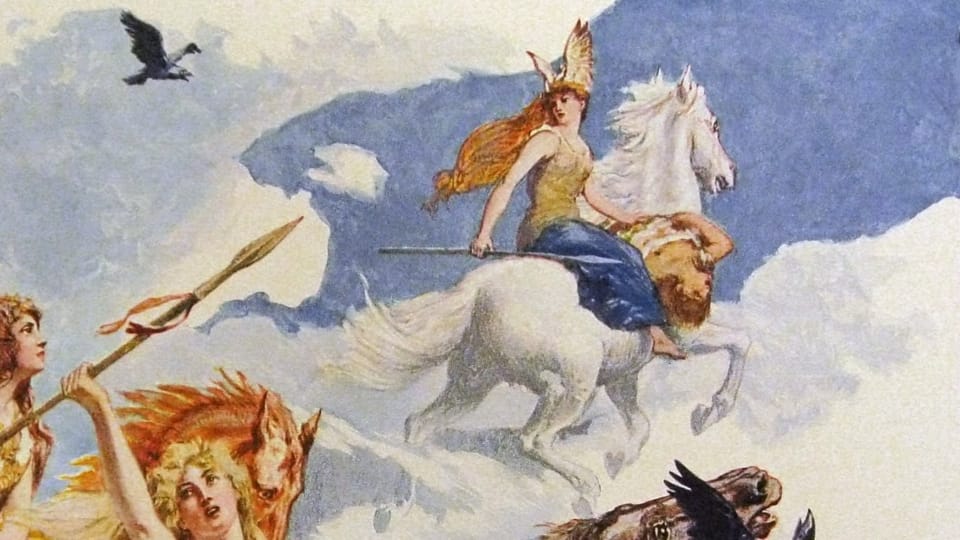Valkyries: The Warrior Maidens of Norse Mythology

Today we’re going deep into some Norse mythology territory. We’re talking Valkyries here, people—those fearsome warrior maidens with swords and attitude, serving none other than Odin, the Allfather himself. And, if you’ve been keeping up with VIKINGS vs SAMURAI, you’d know Brynhildr, one of the key players, rocks the title “Valkyrie.” Why? Because she’s got the kind of fierceness and warrior skill that’d make even the toughest samurai think twice.
Now, in the grand, mystical universe of Norse mythology, few figures are as downright captivating as the Valkyries. These ladies weren’t just hanging around, sipping mead. Nope. They were out there deciding who lived, who died, and who got a golden ticket to Valhalla, Odin’s hall of the fallen warriors. Yeah, that’s right—these women were literally picking the Einherjar, the ultimate Viking warrior squad, for the end-of-the-world showdown at Ragnarök. Over the years, they’ve morphed into icons of fate, war, and everything that screams ‘warrior ethos.’ So, let’s break down why these Valkyries are still kicking ass and taking names, even today.
The name “Valkyrie” comes from the Old Norse word “valkyrja,” which, loosely translated, means “chooser of the slain.” And that ain’t just some fancy title; it pretty much sums up their job description. These were the daughters of gods or other powerful beings, kitted out with armor, spears, shields, and some seriously badass horses that could fly or gallop across the sea. They were front and center in the chaos of battle—terrifying yet somehow inspiring. They were like death’s messengers; trust me, you wanted them on your side.
You see, the Valkyries weren’t just eye candy in the midst of a battlefield—they were Odin’s right-hand women. The big guy himself, god of wisdom, war, and death, sent them out to gather the best of the best from the slain warriors. They were filling Valhalla with the elite, the ones who would stand shoulder to shoulder with Odin when all hell breaks loose at Ragnarök. Think of them as divine talent scouts but with more blood and guts.
But wait, there’s more. These gals were also in the fate business. They didn’t just watch battles—they played a hand in them, deciding outcomes and weaving the fates of men. And let me tell you, their weaving wasn’t some peaceful granny pastime; we’re talking intestines for threads and heads for weights. Real grisly stuff that underlined the harsh reality of Viking battles. So, yeah, Valkyries were in the thick of it, shaping destinies and setting the stage for warriors and kings alike.
While not all shieldmaidens were Valkyries, you bet a lot of Valkyries could swing a sword with the best of them. They were out there, not just picking who’d die but fighting right alongside the men. This duality—as choosers of the slain and as warriors in their own right—ties them to the very fabric of Norse warrior culture. They were tough, unyielding, and way ahead of their time in the gender equality department.
You find these fierce ladies popping up all over the Norse sagas and Eddas, which are like the mythological greatest hits albums of old Norse literature. The Poetic Edda, they’re painted as both mystical and down-to-earth beings. They’re soaring over battlefields, their armor gleaming, deciding who gets the honor of going to Valhalla. In one tale, a Valkyrie named Sigrún even falls for a mortal warrior, showing they had a little bit of that human touch, too.
Then there’s the Prose Edda, where the Valkyries are not just taking names and collecting souls but also serving drinks to the Einherjar in Valhalla. Dual roles, man—keeping it divine yet grounded. And let’s not forget Brynhildr’s namesake, probably the most famous Valkyrie out there. Her story is epic—love, betrayal, revenge. She goes against Odin, gets knocked down to mortal status, and basically sets off a chain of chaos. She’s the OG complex character, caught between duty and desire, divine commands and personal vendettas.
The Valkyries are way more than just mythological figures. They’re symbols, man—symbols of life, death, and honor in a world where dying in battle was considered the ultimate honor. They were these fearsome yet noble gatekeepers of the afterlife, ensuring warriors got their just rewards or punishments. As time rolled on, their image shifted. They became these almost angelic figures in the Romantic period, embodying beauty, strength, and warrior spirit.
Fast forward to today, and the Valkyries are alive and kicking in pop culture. You see them in books, movies, comics, and games. They’re not just warriors but also icons of female empowerment, breaking all the traditional gender molds. Just look at Marvel’s Valkyrie, played by Tessa Thompson—fierce, independent, and not taking crap from anyone. That’s the Valkyrie spirit right there, modernized for a new audience but still true to its roots.
The Valkyries aren’t just relics of ancient stories. They’ve got a presence in today’s spiritual practices, especially in modern Heathenry, where they’re honored as symbols of courage and fate. They’ve become feminist icons, embodying strength and independence, challenging the old-school views of women’s roles both in mythology and society. They’ve been reimagined as symbols of defiance against the status quo, warriors not just in battle but in the fight for equality and recognition.
The Valkyries of Norse mythology are the original badasses. They’re not just part of the old tales—they’re the lifeblood of the Norse warrior ethos. As time’s gone on, they’ve evolved, mirroring our own changing views and values. From ancient warrior maidens to modern-day feminist icons, Valkyries continue to inspire, showing us that their stories are just as relevant today as they were back in the day. So, if you want to dig deeper, check out Jóhanna Katrín Friðriksdóttir’s Valkyrie: The Women of the Viking World. Jóhanna’s book provides invaluable information on Norse history and sagas, so much so that she was one of the historical consultants for The Northman.
